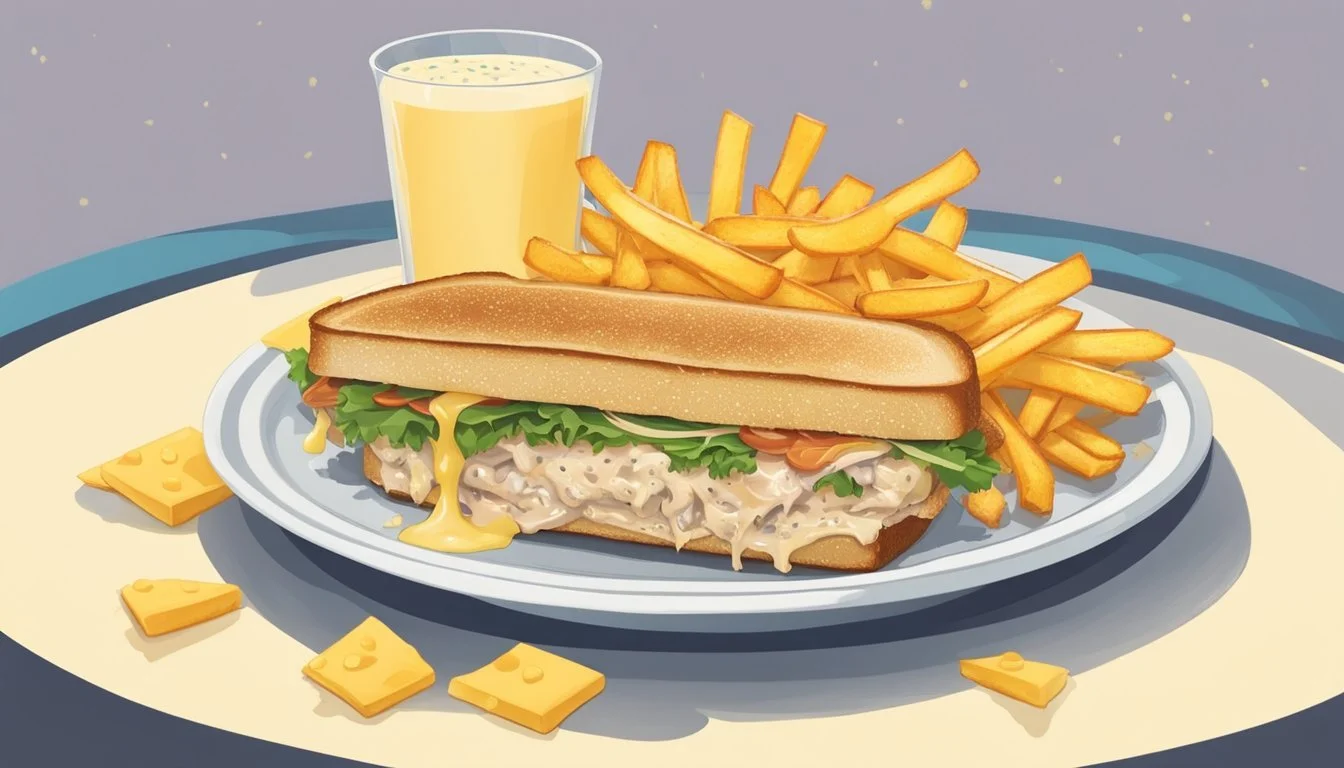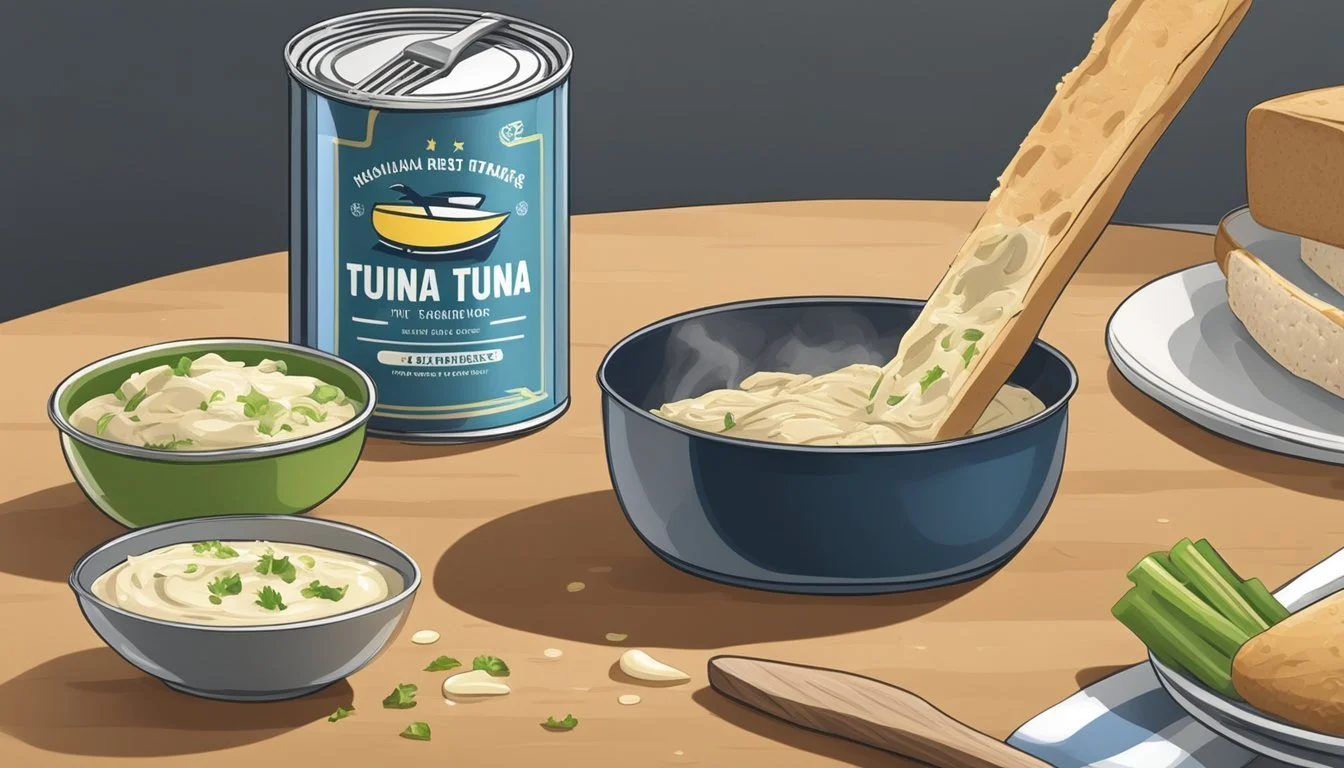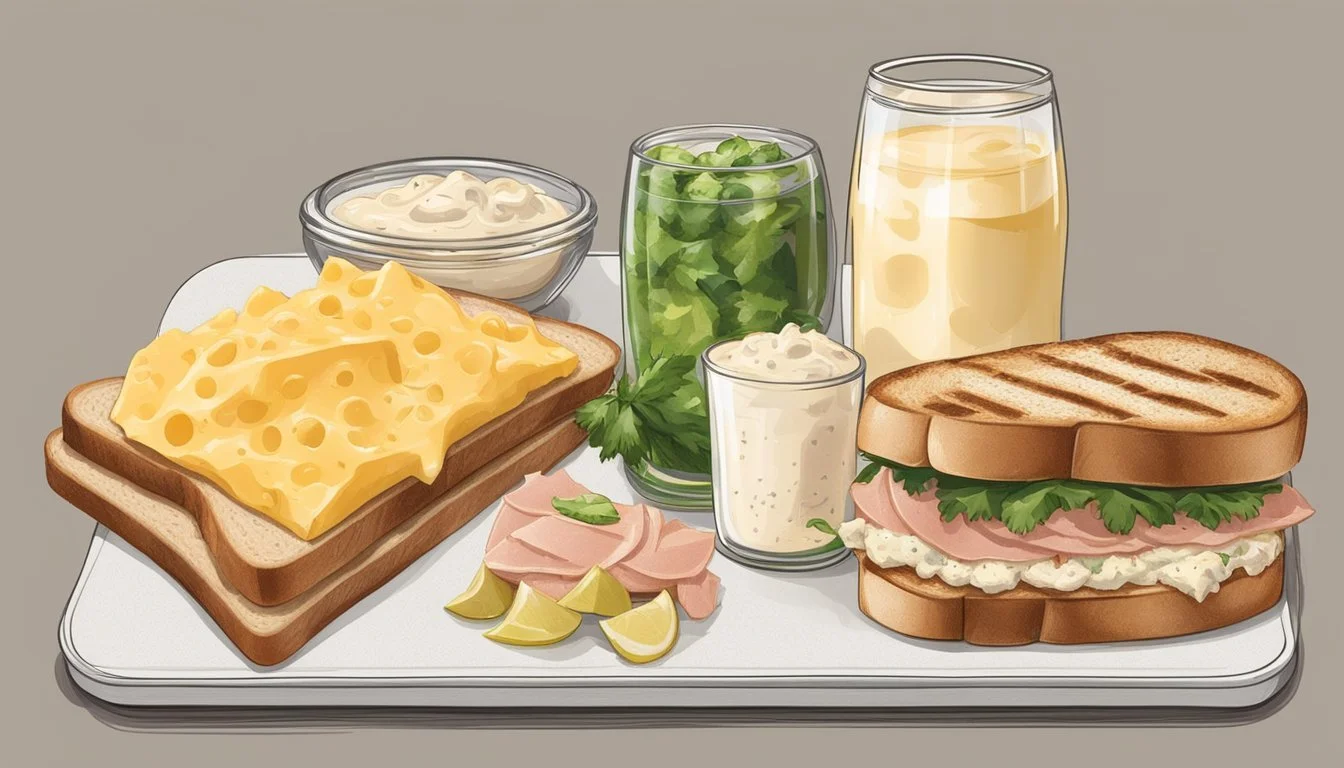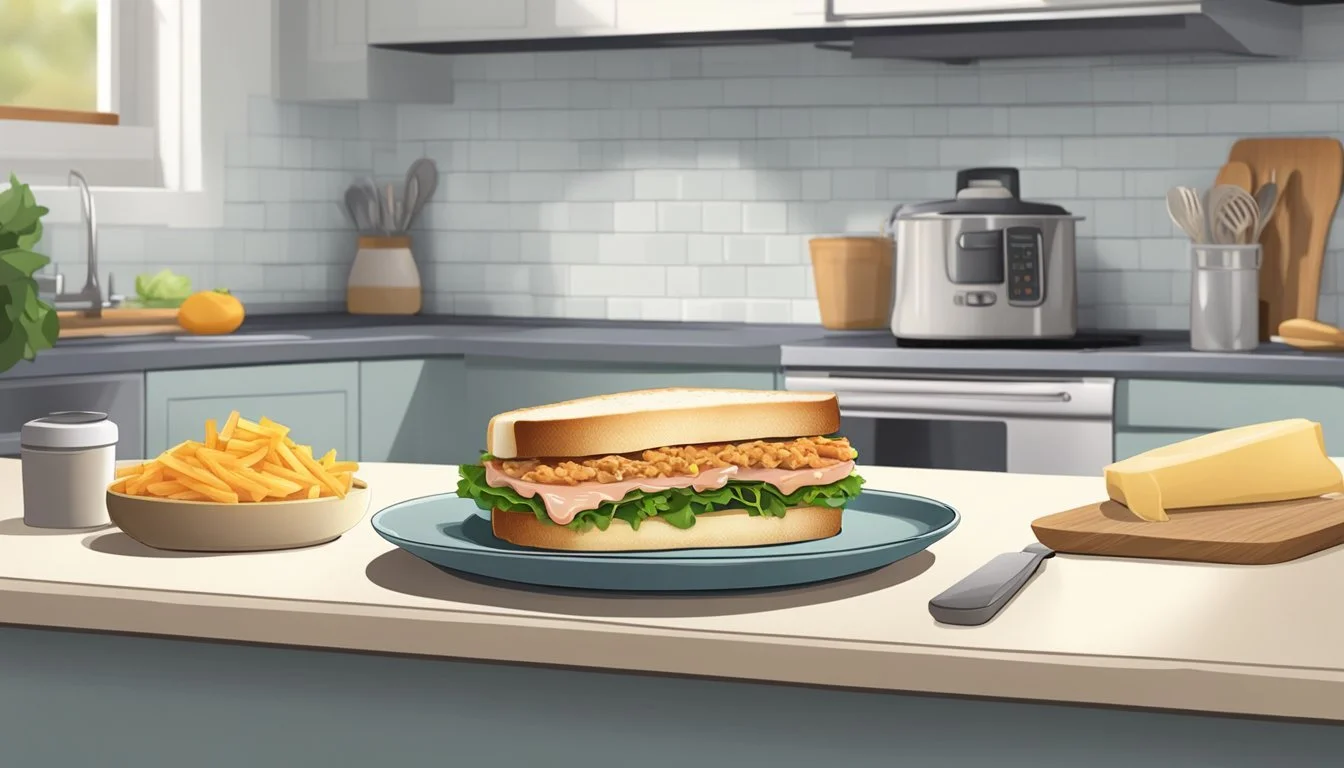How Do You Eat a Tuna Melt?
Mastering the Classic Sandwich Enjoyment
A tuna melt is a classic sandwich that offers a satisfying union of creamy tuna (What wine goes well with tuna?) salad and gooey melted cheese, all nestled between slices of toasted bread (how long does bread last?). Often enjoyed as a comforting lunch or dinner option, it's a beloved dish found in diners, cafes, and kitchens across the globe. Ensuring a balance of flavors is key, with a typical tuna mixture combining mayonnaise, diced celery, and a hint of acidity—like pickled relish or a squeeze of lemon—to complement the richness of the cheese and the crunch of the toasted bread.
When eating a tuna melt, the experience can range from the no-fuss simplicity of a sandwich in hand to a plated meal complete with sides. Its versatility also extends to variations in ingredients, with the addition of items such as chopped onions, capers, or even pickled jalapeños to elevate the filling. The choice of cheese—commonly cheddar, Swiss, or American—melts over the warm tuna creating a delightful texture and taste.
While the preparation and assembly of a tuna melt are straightforward, the execution—the broil or grill that achieves the golden-brown finish and melding of flavors—is crucial. The tradition of serving a tuna melt is deeply engrained in American food culture, marking it not just a meal, but a comfort food staple with a rich history in casual fare dining. Whether it's the simplicity of the ingredients or the heartiness of the sandwich itself, the tuna melt remains a perennial favorite for those seeking a quick and delicious meal.
History and Origin
The classic tuna melt has its roots deeply embedded in American culinary history. Originally, the sandwich is said to have emerged from a serendipitous accident at a lunch counter, where a spill of tuna onto a grilled cheese sandwich inspired an iconic combination. This incarnation took the existing popularity of tuna salad sandwiches (What wine goes well with sandwiches?), a staple dating back to the early 20th century, and combined it with the beloved melted cheese element.
Cheese Selection has evolved over time, with American cheese commonly chosen for its melting properties, creating a gooey and comforting texture that complements the tuna mixture.
Ingredients Typical to a Tuna Melt:
Tuna (canned)
Mayonnaise
Cheese (often American cheese)
Bread slices
Butter or oil, for grilling
The transformation of a simple tuna salad sandwich into the warm and toasted classic tuna melt can be seen as a reflection of American ingenuity in the kitchen – creating something new from an unexpected mishap.
As the sandwich gained popularity, variations began to appear, but the fundamental concept remained the same: the harmony of flavors between the savory tuna, the tang of mayonnaise or other acidic components, and the rich, melted cheese, all encased in crisply toasted bread. This culinary creation continues to hold its place as a comfort food and a testament to the simplicity and inventiveness of American cuisine.
Ingredients and Alternatives
Creating the perfect tuna melt hinges on a harmonious blend of ingredients, each contributing to the overall flavor and texture. Key components include the tuna mix, the choice of bread and cheese, and a few other essential ingredients that balance richness with acidity.
Key Ingredients
Tuna: Canned tuna in water is preferred for its firm texture; it should be well-drained and flaked.
Cheese: Cheddar cheese is commonly used for its sharpness, while Monterey Jack offers a milder option.
Bread: Sourdough and rye are popular choices, providing a sturdy base with a flavorful contrast to the melt.
Mayonnaise: Acts as a binder for the tuna mix and adds creaminess.
Vegetables: Diced celery and red onion provide a crunchy texture and a subtly sweet flavor.
Seasonings: Salt, black pepper, and a hint of lemon juice enhance the overall taste.
Herbs: Dill or parsley can be used to add fresh, aromatic notes.
Butter: Essential for grilling the sandwich to achieve a golden, crispy exterior.
Substitutions
Cheese Alternatives: Provolone, mozzarella, or gouda can replace cheddar for different levels of meltiness and flavor profiles.
Bread Options: If sourdough or rye is not preferred, multigrain or whole wheat can be suitable substitutes.
Mayonnaise Replacement: For a lighter version, Greek yogurt can serve as a substitute, maintaining creaminess while reducing calories.
Adding Acidity: Capers or pickles can be added to the tuna mix for extra tanginess, substituting or complementing the lemon juice.
For Heat: Including chopped pickled jalapeños or a dash of hot sauce can offer a spicy kick.
By understanding each element's role and potential substitutes, one can tailor their tuna melt to personal taste preferences while ensuring the integrity of the classic dish.
Preparing the Tuna
The key to a delicious tuna melt lies in the quality and flavor of the tuna salad. One must achieve a balance of creaminess and zest within the salad to ensure the melt is flavorful and satisfying.
Creating the Tuna Salad
The foundation of any good tuna melt is an expertly mixed tuna salad. Start by draining the canned tuna thoroughly to remove excess liquid. This ensures the salad's consistency remains creamy, not watery. The tuna is then combined with mayonnaise, which acts as a binding agent and contributes to the creaminess of the mixture. Most recipes recommend a proportionate balance, ensuring the tuna retains its integrity without being overwhelmed by the mayo.
Ingredient Quantity Tuna 1 can Mayonnaise 2-3 tbsp Celery 1-2 stalks Red Onion 2 tbsp Dill (how long does dill last?)Pickles 1-2 pickles
To introduce texture and a subtle crunch, finely dice celery and dill pickles. Additionally, finely chopped red onion is usually added for a hint of sharpness and color.
Seasoning the Mixture
An impeccably seasoned tuna salad can elevate the tuna melt from good to great. A pinch of kosher salt and black pepper is essential for enhancing the natural flavors of the tuna. Lemon juice not only imparts a fresh zesty tang but also counterbalances the richness of the mayo. The acidic component provided by lemon juice brightens the overall taste, making the tuna salad more vibrant on the palate.
When the seasoning is complete, one should taste the salad and adjust the seasonings if necessary to ensure a flavorful base for the tuna melt. Remember, the seasoning should complement the tuna, not overpower it.
Assembling the Sandwich
To craft the quintessential tuna melt, one must pay careful attention to the layering of ingredients and employ specific techniques for a flawless stack.
Layering Ingredients
The base of a tuna melt sandwich typically begins with a slice of sourdough bread. An even spread of butter on the outside of the bread ensures a crisp exterior upon grilling. The chef then adds a generous layer of tuna salad on the bread. To complement the creaminess of the tuna salad, sharp and tangy ingredients like mustard can be introduced. This not only adds flavor but also helps balance the richness. Next, cheese, such as cheddar or Swiss, is placed over the tuna. For a refreshing twist, tomato slices can be nestled between the cheese and tuna, introducing a juicy, tangy note to the sandwich.
Tips for a Perfect Stack
When selecting cheese, one should consider how well it melts; a meltable cheese will ensure a unified sandwich where all components come together harmoniously.
Pressing down on the sandwich gently while it cooks helps meld the layers together, creating an integrated flavor profile.
For those desiring a heartier sandwich, an additional piece of cheese can be placed beneath the tuna salad as well as on top, enclosing it in a cheesy embrace.
Because of its crucial role in texture and taste, the choice of bread matters; sourdough holds up well against the moistness of the tuna salad and the melting cheese without becoming soggy.
Cooking Techniques
The art of making a tuna melt involves achieving a balance between a crispy exterior and a melty, flavorful interior. Whether one prefers a skillet, oven, or air fryer, the goal is to cook the sandwich to a golden brown perfection while ensuring the cheese is thoroughly melted.
Skillet Method
Using a skillet is a traditional approach to making a tuna melt. It typically involves:
Preheating a skillet, preferably cast iron, over medium heat.
Placing the sandwich in the skillet, ensuring it is buttered or oiled for a crisp finish.
Cooking until the bread is golden brown and the cheese has melted, flipping once to ensure even toasting.
Oven Baking
The oven baking method allows for preparing multiple sandwiches at once. It requires:
Preheating the oven to a moderate temperature (around 350°F or 175°C).
Laying sandwiches on a baking sheet and baking until the cheese is bubbly and the bread toasty.
Using an Air Fryer
An air fryer offers a healthier option with less oil. The steps include:
Preheating the air fryer to approximately 370°F (187°C).
Cooking the tuna melt for a few minutes until it reaches a desirable crispness and the cheese is melted.
Serving Suggestions
When enjoying the comfort food classic that is the tuna melt, pairing it with the perfect side dish can elevate the meal. The following suggestions focus on balancing flavors and presentation to enhance the dining experience.
Accompaniments
Potato Chips: Their crispy texture contrasts the creamy, melted cheese and soft tuna, providing a satisfying crunch.
Salad: A fresh green salad or a specific type, such as a romaine lettuce salad with mint, offers a refreshing counterpoint to the savory sandwich.
French Fries: Whether standard or sweet potato fries, they are a traditional companion to sandwiches, including tuna melts.
Fruit: A light fruit salad can cleanse the palate and add a sweet note.
Avocado: Its creamy texture and rich flavor pair well when sliced or in a guacamole.
Slaw: A tangy slaw, like a vinegar coleslaw, will complement the tuna melt’s richness.
Tomato Soup: Tomato basil soup serves as a warm, comforting side that partners well with the gooey, cheesy melt.
Presentation Tips
Plate Balance: Creatively arrange the tuna melt with its side to have a mixture of colors and textures, such as the vibrant green of a salad or the golden-brown hue of potato chips or fries.
Individuality: Serve the soup or slaw in a small bowl or cup on the side to keep it tidy and to allow diners to combine flavors at their own pace.
Variations of the Tuna Melt
The classic tuna melt is a beloved staple, but it can be reimagined in several delicious ways. One popular variation is the open-faced tuna melt, which features the tuna salad and cheese atop a single slice of bread, allowing the flavors and textures to shine without an additional bread layer.
For those seeking variety in veggies, consider adding options such as sliced tomatoes, crisp lettuce, or tangy pickles. These ingredients not only bring nutritional value but also introduce new textures and flavors that complement the creamy tuna and melted cheese.
Grilled cheese lovers can transform the traditional sandwich by incorporating the tuna mixture into their favorite grilled cheese recipe. They simply need to add a generous scoop of the tuna salad between layers of cheese and grill until the bread is toasted and the cheese has melted.
Variations by Bread Type:
English muffins: Toasted to add a crispy base.
Rye bread: Offers a robust flavor.
Whole wheat: A healthier alternative maintaining taste.
Tuna Mixture Enhancements:
Celery or onions: For a crunch.
Dijon mustard or lemon juice: To sharpen the taste.
Parsley: To add a touch of herbal freshness.
Through these variations, consumers can tailor their tuna melt experience to personal preferences or dietary needs, ensuring that the timeless sandwich continues to delight in new and exciting ways.
Nutritional Information
A tuna melt can vary widely in nutritional content based on its ingredients, but it generally offers a good balance of macronutrients along with several important vitamins and minerals.
Macronutrients
Calories: A typical tuna melt can range from 300 to 600 calories per serving depending on the size and specific ingredients used.
Protein: It is often high in protein, thanks to the tuna, with amounts typically between 15-30 grams.
Fat: Fat content can vary, especially from the mayonnaise and cheese; expect between 10-30 grams, with a portion of that being saturated fat.
Carbohydrates: The bread adds carbohydrates, contributing to a total of about 20-40 grams per sandwich.
Fiber: This varies based on the type of bread used but typically is around 2-5 grams.
Sugar: Usually low in sugars unless sweetened condiments or bread are used.
Dietary Considerations
Cholesterol & Sodium: Tuna melts can be high in both cholesterol and sodium due to the tuna, cheese, and added condiments.
Potassium: The potassium content can be beneficial for heart health, with tuna providing a natural source.
Vitamin A & Vitamin C: Depending on the additional ingredients like vegetables, these vitamins might be present.
Calcium: Cheese is a good source of calcium, contributing to the melt's overall content.
Dietary Fiber: The choice of bread impacts the fiber content; whole grain options contribute more fiber.
Saturated Fat: Cheese and full-fat mayonnaise increase the amount of saturated fat. Choosing low-fat cheese and mayonnaise can lower this.
A focus on whole grain bread, low-fat condiments, and adding vegetables can improve the nutritional profile of a tuna melt.
Food Safety
When consuming a tuna melt, it's crucial to observe food safety practices, especially since this dish contains perishable ingredients like mayonnaise and tuna. These components can pose health risks if not handled correctly.
Mayonnaise, often a key ingredient in a tuna melt, requires careful handling as it can be a growth medium for bacteria if kept at warm temperatures. To mitigate risk, mayonnaise should be stored in the refrigerator at a temperature below 40°F (4°C) and never left out for more than two hours. Additionally, one should always use clean utensils when scooping mayonnaise to avoid cross-contamination.
For tuna, whether canned or fresh, storage guidelines are critical. Fresh tuna should be refrigerated promptly and used within two days. Canned tuna, once opened, should be transferred to a sealable container if not used immediately and refrigerated. It's safe to consume within three to four days.
Cross-contamination is another concern. To prevent this:
Always use separate cutting boards and knives for different types of ingredients.
Wash hands thoroughly before and after handling different food items.
Disinfect surfaces after preparing each component of the dish.
Storage of the final product—tuna melts—should not be overlooked. If not consumed immediately, store them in the refrigerator within two hours of cooking, and consume them within three days for maximum safety and freshness.
By maintaining these food safety standards, one can enjoy tuna melts with confidence in their meal's safety.







